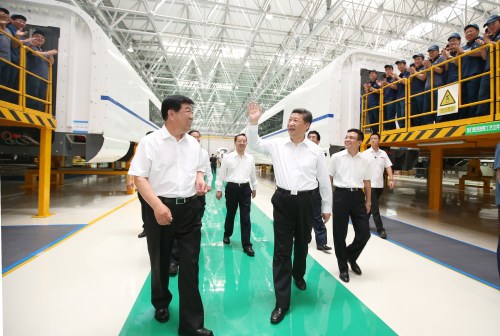
Chinese President Xi Jinping (center) talks with workers during his visit to Changchun Railway Vehicles Co. Ltd. in Changchun, capital of northeast China's Jilin Province, on July 17 (XINHUA)
Three once prosperous northeastern provinces are in dire need of help
Founded in 1954, Changchun Railway Vehicles Co. Ltd. is China's largest manufacturer of railway passenger trains and urban rail vehicles. Located in Changchun, capital of northeast China's Jilin Province, the company, a subsidiary of the newly formed CRRC Corp. Ltd., employs over 13,000 people and occupies a total area of 4.95 million square meters. In 2014, its sales revenue exceeded 30 billion yuan ($4.83 billion), up 22.8 percent year on year. The company's products have been exported to over 18 countries and regions worldwide.
The company has come under media scrutiny since it was visited by two of China's top leaders. On July 17, President Xi Jinping made an inspection tour of the company, three months after Premier Li Keqiang's visit in April.
These visits have been made not only because the state leadership pins high hopes on the development of an advanced equipment-manufacturing sector, but also because of Changchun Railway Vehicles' potential role in the revival of a region mired in unprecedented difficulties.
Jilin, along with neighboring Heilongjiang and Liaoning provinces, used to be one of China's major economic powerhouses, as the three are major heavy industry hubs and boast abundant natural resources. However, as China gradually steers away from reliance on resource- and heavy industry-driven growth, many local cities are struggling to find new growth stimuli, and fresh efforts are needed to revive the fortunes of the region, which stands on the brink of decline.
Desperate times
Occupying one seventh of China's total territory with a population of over 100 million, the three northeastern provinces are of vital significance to the country. In addition to constituting a major grain producer, they had operated as centers for heavy industry manufacturing and energy production for more than four decades following the founding of the People's Republic of China in 1949. Best known as an "old industrial base," the region is where the first piece of China-made steel and first domestically manufactured car were produced.
In the 1990s, however, the economy of the three provinces began to decline after resources were severely over exploited. As China made large strides in reforming its bloated state-owned enterprises (SOEs) at the end of the 1990s, about 30 million workers were laid off, one fourth of whom were in the northeastern region where SOEs accounted for a large proportion of the local economy.
Lackluster economic performance continued into the 21st century. The three northeastern provinces' GDP growth rates were among the bottom five nationwide last year. In 2014, the GDP of Heilongjiang, Jilin and Liaoning grew by 5.6 percent, 6.5 percent and 5.8 percent year on year, respectively, much lower than the national average of 7.4 percent.


















































